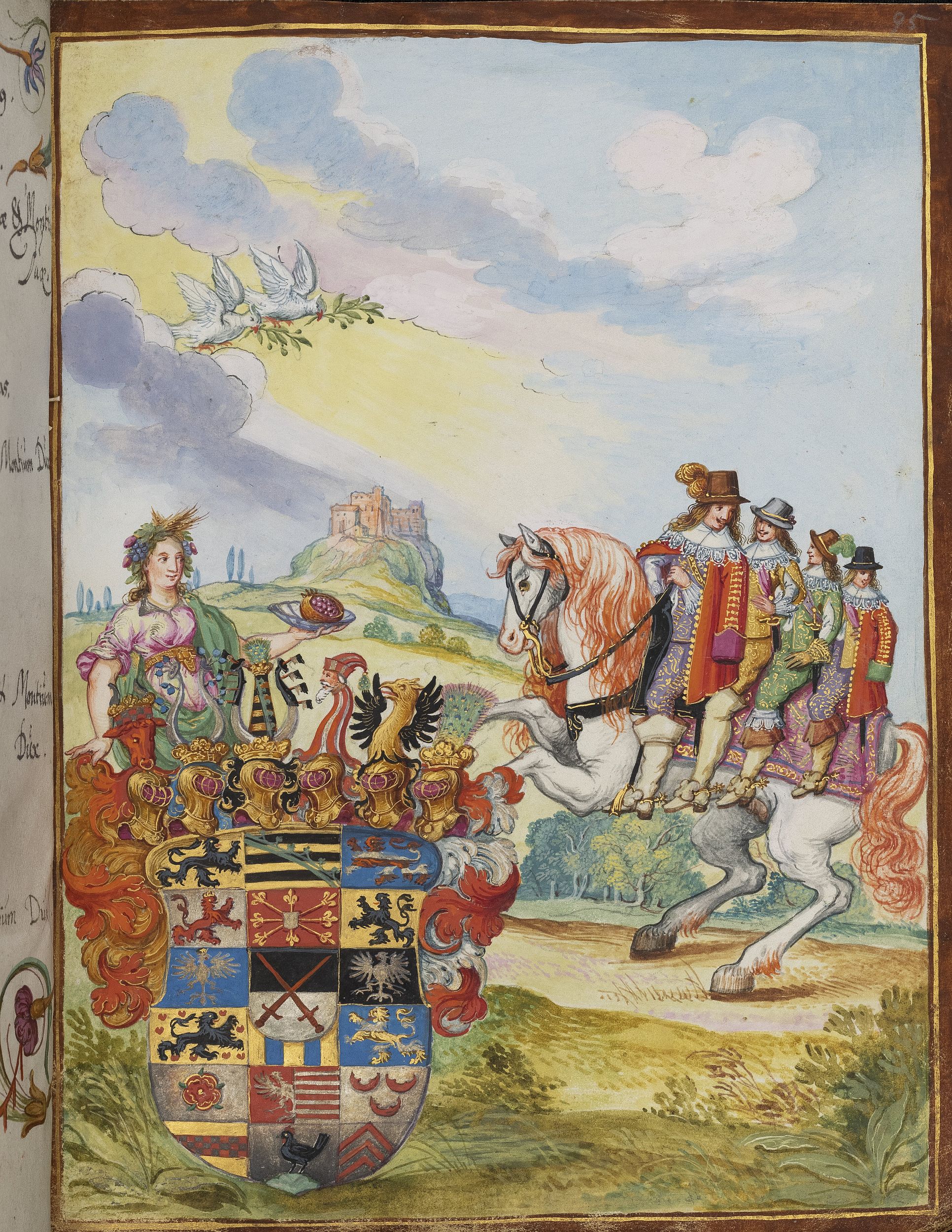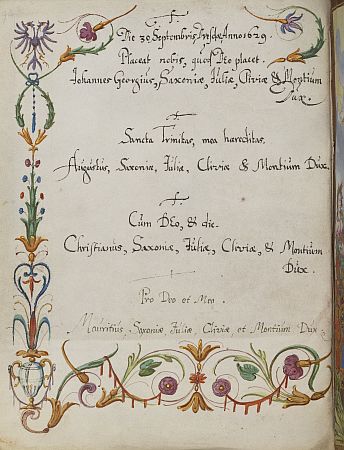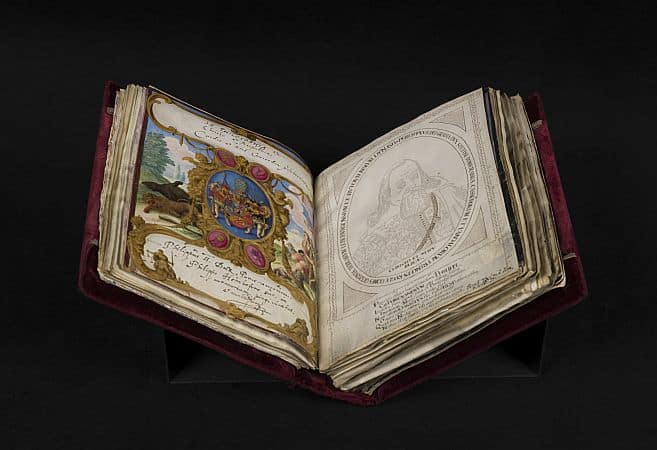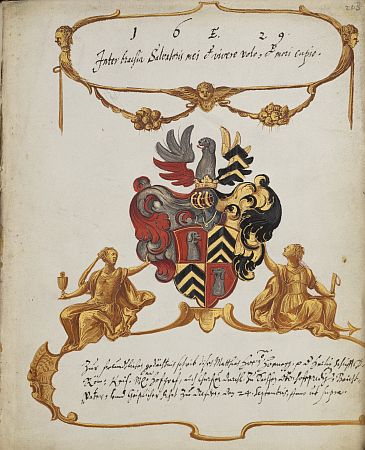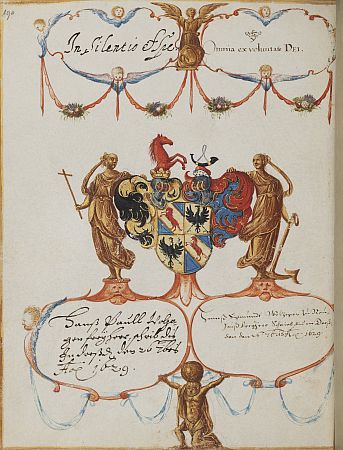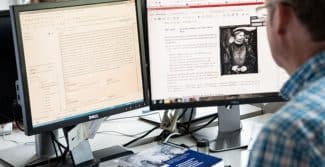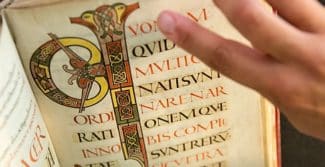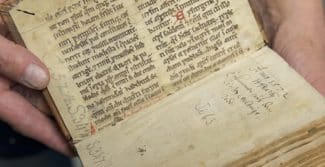27 January 2023
A gouache miniature on parchment (main image) in the Großes Stammbuch of Philipp Hainhofer (1548–1647) depicts a radiant and undulating landscape with a hilltop castle under an azure sky. Two little doves with olive branches in their beaks fly towards a proud steed. Four male figures are sat behind one another on the horse’s back, dressed in the boldly colourful and gold-embellished attire of early 17th-century noblemen. Cloaks and pointed collars donned over pantaloons, doublet and sash. Feathered hats perch atop their long curls; their lower legs are clad in cuffed boots of pale leather with spurs on their heels. The Electorate of Saxony’s coat of arms is visible in the foreground on the left. A female figure wearing a wreath of fruit and ears of corn in her hair presents a conch shell with an opened pomegranate. This heraldic attendant is a symbol of fertility and abundance.
The coat of arms identifies the four noble horsemen as brothers from the House of Wettin. They are the sons of Elector Johann Georg I (1585–1656). The eldest, Elector Prince Johann Georg (1613–1680) sits in front with the reins in his hand, behind him are August (1614–1680), Christian (1615–1691) and the youngest, Moritz (1619–1681), who was just ten years old at the time.
The miniature forms part of a double page. On the left of the image (fig. 2) are Latin mottoes expressing a fear of God, along with the princes’ signatures and the date and place that the drawing was made: Dresden, 30 September 1629. The whole image is framed by stylised flowers and vines.
The double page features all the typical elements of an early modern family album and its opulence declares its role as status symbol. As well as being a popular medium of the culture of memory in the early modern period, family books were an instrument for attracting patrons and allies.
The images and words that immortalise the young Saxon dukes combine to form an idealised image of peaceful and god-fearing rulers, offering the promise of a happy future for their country: the mottoes are encircled inside one common border; the four brothers are riding one horse. Their legacy, a flourishing electorate, stands as firm as the castle on the craggy hilltop. The landscape is bathed in radiant light as are the pair of doves, which allude to the end of the Flood and symbolise peace. And yet the image was created in the midst of the Thirty Years’ War – even if at the time of its creation, Saxony had yet to experience the full devastation of the war.
For Hainhofer, however, the effects were already painfully real, both economically and socially. In the first half of the 17th century, the Augsburg merchant had been an important agent for a number of German princes, dealing in both art and information. In 1629 he travelled to Dresden as a member of a Protestant delegation to ask Elector Johann Georg I for assistance in mitigating the consequences of the Edict of Restitution in Augsburg. Emperor Ferdinand II (1578–1637) had issued the edict with the aim of permanently placing the Catholic side at an advantage.
Soirées, hunts and church visits brought Hainhofer into contact with an assortment of people all across Saxony. He capitalised on this opportunity, using his charms, talents and vigorous determination to add more entries to his family book, which at the time already contained over 100 decorative pages and signatures (fig. 3). Examples of contributors from this time include the Saxon senior court chaplain Matthias Hoë von Hoënegg (1580–1645) as well as his cousins and protégés Hans Paul (1591–1658) and Hans Sigismund (1606–1632) von Wolzogen, who had come to Saxony as religious refugees (figs. 4 and 5).
Twelve years earlier, Elector Johann Georg I himself had promised Hainhofer that his chamber painter, Johann Fasold (c.1570–c.1619) would make an entry in his family album – a promise, however, that apparently failed to materialise. When Hainhofer met the Elector in 1629, it was primarily his wife, Electress Magdalena Sibylle (1586–1659), who helped Hainhofer along his path to success. She invited him to her private rooms, looked at the family album and agreed to make an entry herself and even to sit for a portrait by Lucas Kilian (1579–1637), who had travelled with her. While the portrait is verifiable, her entry in the family book seems to have been lost. Thus, today, the double page portraying her sons is the only record of Hainhofer’s visit to the electoral family. They invited him to dinner on 8 October to look at the family album. It may even have been on this occasion that the small portrait of the four dapper horsemen was added to the album.
This is just one of many stories that could be told about the 107 pages, dedicated to 94 individuals, that are preserved today, decorated mainly with colourful miniatures and pen-and-ink drawings. Together they form a precious treasure that provides a unique insight into the workings of artistic, political, diplomatic and social networks in the first third of the 17th century.
Hainhofer’s Großes Stammbuch was acquired from private ownership for the Herzog August Bibliothek in 2019. It is currently being catalogued in depth by scholars as part of a research project whose results will be made freely accessible to the public online, together with a digital edition of the book that presents it in its full glory.
Image (top): Philipp Hainhofer’s Großes Stammbuch, HAB, Cod. Guelf. 355 Noviss. 8°, p. 95
